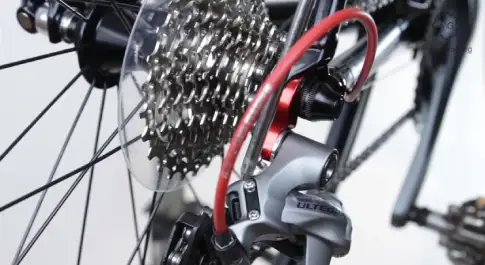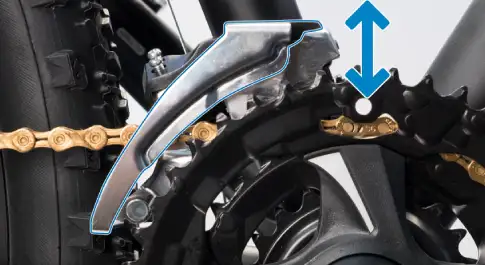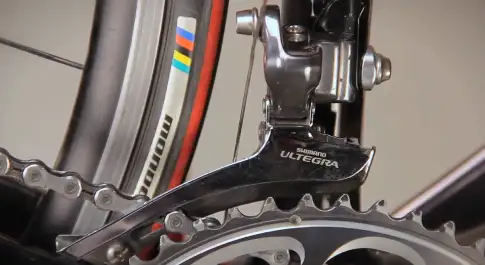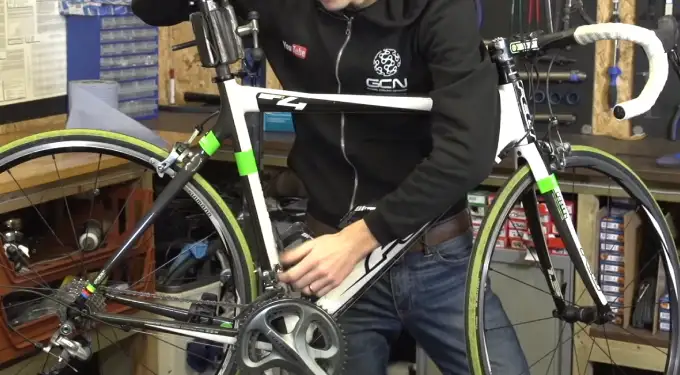Adjusting the front derailleur is a process where you make sure that the chain is tensioned correctly and is able to move between different gears smoothly. Most of the time, this process is done using a barrel adjuster. However, there are some cases where you may not have a barrel adjuster, or it may not be working correctly.
In these cases, you will need to know how to adjust front derailleur without barrel adjuster. Don’t worry, and it’s not as complicated as it sounds. With a few simple steps, you’ll be able to get your front derailleur tuned and working correctly in no time.
What is a Front Derailleur?

Before we get into how to tune a front derailleur without a barrel adjuster, let’s first go over what a front derailleur is and how it works.
A front derailleur is a component on a bicycle that helps to move the chain from one chainring to another. It consists of two main parts: the cage and the parallelogram. The cage is the part that holds the chain and guides it onto the different chainrings. The parallelogram is the part that moves the cage back and forth, changing the gear that the chain is in.
When you shift gears on your bicycle, the front derailleur moves the chain onto a different chainring. This is done by the parallelogram moving the cage back and forth, pushing or pulling the chain onto the different chainrings.
What Will You Need?
In order to tune the front derailleur without a barrel adjuster, you will need the following tools:
- A flat head screwdriver
- A Phillips head screwdriver
- A pair of needle-nose pliers
- A cable cutter (optional)
- A rag or a piece of cloth
How to Adjust Front Derailleur without Barrel Adjuster: The Easiest Guide
Now that you have gathered all the tools you need, it’s time to start adjusting your front derailleur. Follow these simple steps and you’ll have it adapted in no time.
1. Adjust to the Right Height:
The first step is to make sure that your front derailleur is positioned at the correct height.
In order to do so, loosen the two screws that hold the front derailleur in place (one on the top and one on the bottom). Then, use your hand to adjust the position of the front derailleur until it is in line with the large cog on your rear derailleur. Once you have it in the correct position, tighten the screws to hold it in place.
2. Adjust the Limit Screws:

The next step is to adjust the limit screws on your front derailleur. The purpose of these screws is to make sure that the chain doesn’t fall off of the gears when you are shifting.
First, to adjust the limit screws, loosen the screws that hold the front derailleur. Then, use your screwdriver to turn the limit screws until the chain is able to move smoothly between all of the gears without falling off. Once you have the limit screws appropriately adjusted, tighten the screws to hold the front derailleur in place.
3. Cable Tension:
The next step is to adjust the tension on the cable that runs from the shifter to the front derailleur. This will ensure that the chain is able to move smoothly between all of the gears.
Loosen the screw that holds the cable in place to adjust the cable tension. Then, use your hand and a rag to pull the cable tighter or loosen it until the chain is able to move smoothly between all of the gears. Once you have the correct tension, tighten the screw to hold the cable in place.
4. Trim the Cable:
If you find that the chain is still not moving smoothly between all of the gears, you may need to trim the cable.
Use your cable cutter to remove a small amount of the cable to do this. Then, retest the shifting to see if it is smoother. If it is not, you can trim more off the cable until it is shifting smoothly.
5. Shifting:
Once you have completed all of the above steps, your front derailleur should be tuned and ready to go.
To test it out, shift through all gears to make sure that the chain is moving smoothly. If it is not, double-check all of the steps above to ensure they are all correct.
6. Derailleur Trim:
If the chain is still not shifting smoothly, you may need to adjust the derailleur trim. The derailleur trim tells the front derailleur how far to move when you shift gears.
To adjust the trim, locate the screw on your shifter that controls it. Then, turn the screw until the chain is shifting smoothly between all gears.
With these simple steps, you should now be able to adjust the front derailleur on your bike without a barrel adjuster. You’ll ensure that your bike is shifting smoothly and correctly by following these steps.
The Most Common Problems with Front Derailleurs

Now that you know how to tune a front derailleur without a barrel adjuster, it’s essential to understand some of the most common problems. By learning about these problems, you can avoid them and keep your bike shifting smoothly.
1. Chain Rub:
One of the most common problems with front derailleurs is chain rub. This occurs when the chain rubs against the front derailleur while you are pedaling, which can cause noise and/or damage.
Make sure that your front derailleur is properly adjusted to avoid this problem. If the chain is rubbing against the derailleur, it may be because it is not in the correct position. Use the steps above to adjust the front derailleur until the chain is no longer rubbing against it.
2. Chain Drop:
Another common problem with front derailleurs is chain drop. This occurs when the chain falls off the gears while pedaling, which can be dangerous.
In order to avoid this problem, make sure that your limit screws are properly adjusted. These screws are what keep the chain from falling off of the gears, so if they are not properly adjusted, the chain may drop. Use the steps above to adjust the limit screws until the chain can no longer fall off of the gears.
3. Shifting Problems:
If you are having trouble shifting gears, it is likely due to one of the following problems:
- The chain is not in the correct position on the gears. Make sure that the chain is correctly positioned on the gears before trying to shift.
- The front derailleur is not properly adjusted. Use the steps above to adjust the front derailleur until the chain is able to move smoothly between all of the gears.
- The shifter is not correctly adjusted. If your shifter is not correctly positioned, it may be difficult to shift gears. Use the steps above to adjust the shifter until it is in the correct position.
4. Derailleur Hanger:
If your front derailleur is not working correctly, it may be due to a problem with the derailleur hanger. The derailleur hanger attaches the front derailleur to the bike’s frame, so if it is bent or damaged, the front derailleur may not work correctly.
If you think that the derailleur hanger may be the problem, look at it to see if it is bent or damaged. If it is, you will need to replace it.
5. Cable Stretch:

Another common problem with front derailleurs is cable stretch. This occurs when the cables stretch over time, which can cause shifting problems.
In order to prevent this problem, it is important to maintain your cables regularly. This includes lubricating them and replacing them when they become worn out. You can also avoid this problem by using high-quality cables.
Conclusion
We have outlined the steps above that outline how to adjust a front derailleur without using a barrel adjuster and the most common problems that can arise while the derailleur is being adjusted.
You should be able to keep your bike shifting smoothly after learning these tips. It is very easy to fix any of these problems by simply following the steps listed above. Thanks for taking the time to read this.

